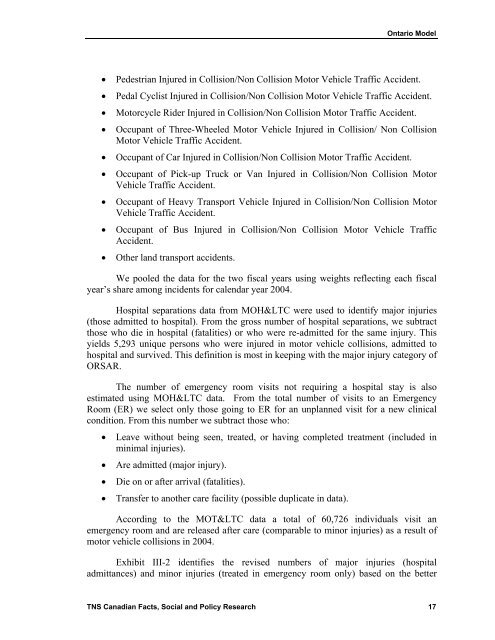Keith Vodden Dr. Douglas Smith - Transports Canada
Keith Vodden Dr. Douglas Smith - Transports Canada
Keith Vodden Dr. Douglas Smith - Transports Canada
Create successful ePaper yourself
Turn your PDF publications into a flip-book with our unique Google optimized e-Paper software.
Ontario Model<br />
• Pedestrian Injured in Collision/Non Collision Motor Vehicle Traffic Accident.<br />
• Pedal Cyclist Injured in Collision/Non Collision Motor Vehicle Traffic Accident.<br />
• Motorcycle Rider Injured in Collision/Non Collision Motor Traffic Accident.<br />
• Occupant of Three-Wheeled Motor Vehicle Injured in Collision/ Non Collision<br />
Motor Vehicle Traffic Accident.<br />
• Occupant of Car Injured in Collision/Non Collision Motor Traffic Accident.<br />
• Occupant of Pick-up Truck or Van Injured in Collision/Non Collision Motor<br />
Vehicle Traffic Accident.<br />
• Occupant of Heavy Transport Vehicle Injured in Collision/Non Collision Motor<br />
Vehicle Traffic Accident.<br />
• Occupant of Bus Injured in Collision/Non Collision Motor Vehicle Traffic<br />
Accident.<br />
• Other land transport accidents.<br />
We pooled the data for the two fiscal years using weights reflecting each fiscal<br />
year’s share among incidents for calendar year 2004.<br />
Hospital separations data from MOH<C were used to identify major injuries<br />
(those admitted to hospital). From the gross number of hospital separations, we subtract<br />
those who die in hospital (fatalities) or who were re-admitted for the same injury. This<br />
yields 5,293 unique persons who were injured in motor vehicle collisions, admitted to<br />
hospital and survived. This definition is most in keeping with the major injury category of<br />
ORSAR.<br />
The number of emergency room visits not requiring a hospital stay is also<br />
estimated using MOH<C data. From the total number of visits to an Emergency<br />
Room (ER) we select only those going to ER for an unplanned visit for a new clinical<br />
condition. From this number we subtract those who:<br />
• Leave without being seen, treated, or having completed treatment (included in<br />
minimal injuries).<br />
• Are admitted (major injury).<br />
• Die on or after arrival (fatalities).<br />
• Transfer to another care facility (possible duplicate in data).<br />
According to the MOT<C data a total of 60,726 individuals visit an<br />
emergency room and are released after care (comparable to minor injuries) as a result of<br />
motor vehicle collisions in 2004.<br />
Exhibit III-2 identifies the revised numbers of major injuries (hospital<br />
admittances) and minor injuries (treated in emergency room only) based on the better<br />
TNS Canadian Facts, Social and Policy Research 17
















